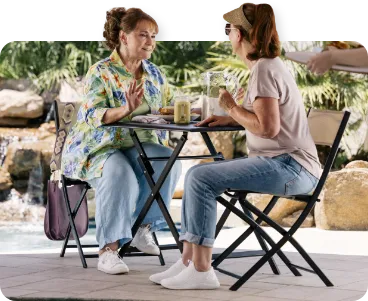
SHANNON
Real GLASSIA patient since 2022
Infuses at home with a nurse
Looking for more information on GLASSIA® or treatment for Alpha-1 antitrypsin deficiency (AATD)?
Whether you’re getting ready for your GLASSIA infusion or you just want useful information about treating Alpha-1 antitrypsin deficiency, download these resources to get you started or to help answer any questions.
What to know when starting GLASSIA treatment.

Our patient brochure provides information about GLASSIA, including the infusion setting options available to you. You’ll learn how GLASSIA helps increase Alpha-1 antitrypsin protein levels and what to expect with treatment, and we’ve included resources to help guide you on your treatment path.
With GLASSIA treatment, you or a caregiver can learn how to infuse* at home.
See how it’s done with our video.
*If self-infusion is deemed appropriate, ensure that you receive detailed instructions and adequate training on how to infuse at home or other appropriate setting and have demonstrated the ability to independently administer GLASSIA.
Video transcript
NURSE: Hello, my name is Catia. Thanks for joining us. I know for many of you the idea of infusing, especially by yourself, might seem a little overwhelming, but today we’re going to talk through the process for self-infusing GLASSIA at home. You’ll receive training from a healthcare professional who will walk you through every step of the process until you feel comfortable infusing on your own. This training may occur in an infusion suite, or it may be done in your home. We hope with these resources you can feel a bit more confident with the infusion process, but before we get to that, let’s go over some Important Safety Information.
VOICEOVER: GLASSIA is a medicine used to treat adults with lung disease, also called emphysema, caused by severe Alpha-1 Antitrypsin Deficiency.
GLASSIA increases the levels of the Alpha-1 Antitrypsin protein in your blood and lungs.
It is not known if increasing Alpha-1 Antitrypsin levels with GLASSIA affects worsening lung function or emphysema progression, and the long-term effects of treatment have not been studied.
Glassia can cause severe allergic reactions including hives, swelling in the mouth or throat, itching, tightness in the chest, trouble breathing, wheezing, faintness, or low blood pressure.
NURSE: Now, let’s meet our patient Trudy, and her husband, Tom. Trudy, Tom, why don’t you tell us about yourself?
TRUDY: Thanks, Catia. I am Trudy. I’ve been infusing with GLASSIA for some time now, and this is my husband, Tom.
TOM: I really like to help my wife any way I can, and when it came to GLASSIA, it was no different.
NURSE: With this tutorial, we’ll give you a look at what’s involved in a GLASSIA self- infusion. Remember, you can always reach out to your doctor if you have questions or concerns. Now, let’s get started. Remember, if the protective cap is missing or broken on the vial, don’t use it. Check the vial of GLASSIA. Before infusing, check the expiration date. Make sure you let GLASSIA reach room temperature. Also, you don’t want to apply heat on the vial or place it in hot water or a microwave. Do not use if the product is cloudy, and do not shake the vial. Let’s check the color. It should be clear and colorless to yellow green, but the vial may contain a few protein particles.
Trudy, how do the vials look?
TRUDY: Everything looks good.
NURSE: Perfect. Next, let’s gather the supplies we need. The materials you need include clean gloves, if necessary, GLASSIA product vials, alcohol swabs, 60-milliliter sterile syringe or syringes, vented spike or spikes, transfer needle or needles, sterile IV infusion container bag, if necessary, administration infusion set tubing, 5-micron inline filter, minimum of 32-millimeter diameter is recommended for optimal performance, tourniquet, intravenous IV needle set, extension set, if necessary, saline flush, bandage, tape, sterile gauze, your infusion journal, sharps container and IV pole or hook.
Talk to your healthcare professional about how you might be able to get these items from a pharmacy or trusted medical supply location.
Now that we have all the supplies we need, let’s lay everything out. First, you want to prepare a clean, flat surface and gather all the materials you will need for the infusion. If a drip chamber is used, it must not contain a filter. If your doctor has prescribed an epinephrine pen and/or other supportive care for certain severe allergic symptoms, keep it close by during your infusion. Be sure to carefully follow your doctor’s instructions and training if you have to administer the prescribed medicine for a severe allergic reaction.
Now, let’s wash then dry our hands. When assisting with GLASSIA infusions, it’s vital that the care partner always washes their hands as well. Remember to put on your gloves if you are directed to do so by your healthcare professional. Now we can open the supplies.
TRUDY: All the supplies are here, and the area is clean. I’m ready to continue.
NURSE: Great. Now we will prepare the vials for infusion. First, we’ll remove the protective cap from the vials. Now wipe the stopper of each vial in your dose with a sterile alcohol swab and allow the stopper to dry.
As directed by your healthcare professional, you need to infuse directly from the vial or pool the recommended number of vials of GLASSIA into an empty sterile container for intravenous infusion. Remember, you must use the product within three hours of entering the vial or pooling it into a sterile container.
Now, if you’re pooling into a sterile container, you’ll need to follow these next steps closely. First, attach a vented spike to a sterile syringe. Then insert the vented spike into the center of the GLASSIA vial. Go ahead and turn the vial upside down and pull back on the plunger to pull the GLASSIA solution into the syringe. Then twist to remove the syringe from the vented spike.
Point the syringe tip up and gently push the plunger up the syringe to remove the air. Attach a transfer needle to the filled syringe.
Use an alcohol swab to wipe the injection port on the empty sterile container. Remove the protective cover of the needle and insert the needle into the injection port. With the needle inserted, we can now fill the empty bag.
You can repeat these steps if you’re using multiple vials to achieve the necessary dose. Discard the syringe and needle in a sharps container.
TRUDY: All right. I have my GLASSIA vials, and my sterile container all set up.
NURSE: Great job, Trudy. Next, we’ll prepare the IV infusion set. First, close the roller clamp on the IV. Then attach the inline 5- micron filter to the end of the IV. And if necessary, you can attach an extension set.
Remove the cap from the IV infusion set spike and insert the spike more than halfway into the infusion port on the GLASSIA bag. Hang the pooling bag from an IV pole or hook. Squeeze the drip chamber until it is half-full and fill the IV infusion set. Close the clamp.
Now that the infusion set is ready, let's prepare the infusion site. You'll start by selecting the infusion site.
Make sure to rotate infusion-site locations with each infusion. Apply a tourniquet and get the injection site ready by wiping your skin with an alcohol swab and wait for your skin to dry. When helping someone with a GLASSIA infusion be sure to keep track of the chosen infusion-site location.
Doing so will help you ensure that the infusion sites are rotated after each infusion. Your healthcare provider will help you understand the best infusion sites for you.
Perfect. We're almost there. Now insert and secure the IV needle set. Release the tourniquet and draw back slightly on the syringe to check for blood return. The presence of blood means the needle placement is correct. If there is no blood present, repeat the steps.
Flush the IV needle set with normal saline. Then just remove the saline- flushed syringe and attach the IV infusion set filled with Glassia solution.
TRUDY: Okay. I'm ready to start.
NURSE: Great. We’re now ready to begin infusing GLASSIA. Open the roller clamp and administer your GLASSIA solution at room temperature at a rate as directed by your healthcare professional. The maximum recommended infusion rate for GLASSIA is 0.2 milliliter per kilogram of body weight per minute.
From here your infusion should only take approximately 15 minutes at the recommended dose and maximum infusion rate. During your infusion you'll want to check on your IV site occasionally for any signs of complications or unusual occurrences. Make sure that the drug is flowing and there is no bleeding. All right, now that we're infusing, all we need to do is wait. We'll check back with Trudy once the infusion is complete.
During this time some patients may like to read, listen to music, or watch videos. How you use your infusion time is up to you.
All right. Approximately 15 minutes have passed, and we're ready to check on Trudy. How are you feeling, Trudy?
TRUDY: I feel pretty good. I got caught up on my new book. Having these infusions at home really makes the whole experience more comfortable for me.
NURSE: Great to hear. Some patients may experience side effects. The most common side effects for GLASSIA are headache and upper respiratory tract infections. Other possible side effects of GLASSIA include: cough, sinus infection, chest discomfort, dizziness, increased liver enzymes, shortness of breath, nausea, and fatigue. Keep in mind these are not all the possible side effects of GLASSIA. Talk to your doctor about any side effect that bothers you or does not go away. When the infusion is complete, you can take the needle out of your vein and use sterile gauze to put pressure on the infusion site. Remember to keep pressure for several minutes.
Now, just apply a sterile bandage. Make sure to not recap the IV needle set to help avoid punctures or accidents which can occur when attempting to recap. Instead, place the needle in a hard-walled sharps container for proper disposal. You don't want to dispose of these supplies into your trash at home. If you don't have a sharps container, you can always request it from your pharmacy or medical supply store.
Now that the infusion is done, we just have one final step. After each GLASSIA infusion, it is important that you record your infusion. You can find your infusion journal located in your GLASSIA Welcome Kit or by calling Takeda Patient Support if you have not received one.
Go ahead and write down the following in your treatment record infusion log: The product lot number and expiration date; the date and time, start and end; the dose and site of infusion to assist in rotating sites; and any reactions you may have experienced after each infusion. Report any and all reactions you may have experienced to your doctor. Make sure to throw away all open vials and any unused solution into a sharps container as recommended by your health care professional. Now that we've recorded the necessary information in your infusion log, we are done with our GLASSIA infusion. Thank you so much for all your work today, Trudy and Tom.
TRUDY: Thank you, Catia. I appreciate your time to help make sure that we are following the correct procedure.
NURSE: And remember, you can always have more training depending on how comfortable you and your nurse feel about your progress. You also have resources available should you need them and if you have any questions, talk to your doctor.
VOICEOVER: What is GLASSIA?
GLASSIA is a medicine containing human Alpha1-Proteinase Inhibitor (Alpha1-PI) that is used to treat adults with lung disease (emphysema) because of severe Alpha1- antitrypsin (Alpha1) deficiency. GLASSIA is not meant to be used as a therapy for lung disease other than severe Alpha1 deficiency. Effects of GLASSIA on worsening lung function and emphysema progression have not been proven in clinical trials. Long-term effects of Alpha1 replacement and maintenance therapy have not been studied.
IMPORTANT SAFETY INFORMATION
What is the most important information I need to know about GLASSIA?
- GLASSIA can cause severe allergic reactions including hives, swelling in the mouth or throat, itching, tightness in the chest, trouble breathing, wheezing, faintness or low blood pressure
- If you will be taking GLASSIA outside a healthcare setting, ask your healthcare provider (HCP) about an epinephrine pen and/or other supportive care for certain severe allergic reactions.
Who should not use GLASSIA?
Do not use GLASSIA if you:
- Have immunoglobulin A (IgA) deficiency with antibodies to IgA
- Have a severe allergic reaction to human Alpha1-PI products
What are the possible or reasonably likely side effects of GLASSIA?
If any of the following problems occur, contact your healthcare provider (HCP) or call emergency services right away:
- Worsening or flare-up of your chronic obstructive pulmonary disease (COPD)
- Hives, swelling in the mouth or throat, itching, chest tightness, trouble breathing, wheezing, fainting or dizziness. These could be signs of a serious allergic reaction.
What are the possible or reasonably likely side effects of GLASSIA?
The most common side effects that may occur are headache and upper respiratory tract infections
Other possible side effects of GLASSIA include:
- Cough
- Sinus infection
- Chest discomfort
- Dizziness
- Increased liver enzymes
- Shortness of breath
- Nausea
- Fatigue
These are not all the possible side effects. Tell your HCP about any side effect that bothers you or that does not go away.
For additional safety information, please see Information for Patients including Detailed Instructions For Administration found on this website and discuss with your HCP.
You are encouraged to report negative side effects of prescription drugs to the FDA. Visit www.fda.gov/medwatch, or call 1-800-FDA-1088.

Already enrolled and want to connect?
Our support specialists are never more than a tap or a call away—
1-866-888-0660, Monday through Friday, 8:30 AM to 8 PM ET.
If English is not your preferred language, let your Takeda Patient Support
specialist know. The team can communicate with you over the phone in a variety
of languages—using a translation service.
Receive this Welcome Kit
when you start GLASSIA treatment.
If you and your doctor decide infusion at home is right for your lifestyle, you will receive our Welcome Kit to help you start on your treatment journey. The kit includes:

dates and infusion details

infusion guide

treatment area sanitary

your infusion experience
Talk to your doctor about the GLASSIA home infusion option.
Learn about insurance and financial assistance options.
Need help with navigating the financials of your Takeda treatment? Below you’ll find a variety of resources that may help you understand things like Medicare, out-of-pocket costs, and general insurance information.

General Insurance Education
A useful resource that clarifies the differences between the 4 types of health insurance plans—HMO, PPO, EPO, HDHP—and explains insurance terms.
DOWNLOAD PDF
Medical vs Pharmacy Benefit
A helpful guide that explains the differences between medical and pharmacy benefits, ways to save money on medications, and how to fill prescriptions at home.
DOWNLOAD PDF
Patient Out-of-Pocket Costs
A useful guide with details about programs that offer help covering medical and prescription drug costs.
DOWNLOAD PDF
All About Medicare
Discover your options when it comes to choosing Medicare, including how the different parts work, cost sharing, and open enrollment.
DOWNLOAD PDFAlphas talk about their experience with GLASSIA treatment.
Wonder what it’s like to receive GLASSIA infusions? Individuals share their patient stories in these short videos.




Stay connected. Stay informed.
Sign up for more information about GLASSIA and AATD treatment.
Sign up for updates![GLASSIA [Alpha1­Proteinase Inhibitor (Human)] logo.](/dist/images/patient/glassia_logo_white.svg)